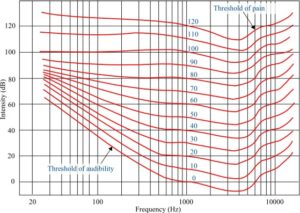 Every decision you make shapes your final mix, and the volume at which you listen significantly influences your perception and choices. Understanding how volume affects your mix can greatly enhance your work.
Every decision you make shapes your final mix, and the volume at which you listen significantly influences your perception and choices. Understanding how volume affects your mix can greatly enhance your work.
At lower volumes, our ears are more sensitive to midrange frequencies, making instruments like vocals and guitars seem louder relative to bass and treble. Conversely, at higher volumes, bass frequencies become more prominent due to the way our hearing works. This can lead to the bass feeling too loud, tempting you to turn it down to what seems like a balanced level. However, when you play the mix back at lower volumes, the bass may sound too weak because you adjusted it during a louder session. Additionally, mixing at high volumes might lead to boosting midrange elements, resulting in an overly pronounced midrange at lower levels.
The Fletcher-Munson curve, shown above, illustrates how the human ear perceives different frequencies at various volume levels.
Mixing at lower volumes helps ensure better balance and clarity. It prevents ear fatigue, allowing for longer, more accurate sessions, and makes subtle details more noticeable, leading to a polished final product.
But, how low is low? How can we find the right mixing volume
Choosing between 75 dB and 85 dB SPL depends on your preference, music style, and environment. Regularly check your mix at both levels to ensure it translates well. Notable engineers like Bob Clearmountain mix at 85 dB SPL, Chris Lord-Alge at 75 dB SPL, Bob Rock at 85-90 dB SPL, and Tchad Blake and Andrew Scheps at 70-75 dB SPL.
Mixing at 75 dB SPL reduces ear fatigue, improves balance, ensures better translation across playback systems, and reveals subtle details. However, it may underestimate bass and treble, and the mix might lack energy.
Mixing at 85 dB SPL offers a flatter frequency response, better energy and impact, and aligns with industry standards. However, it can cause quicker ear fatigue and may exaggerate room imperfections.
Finding the “sweet spot” in volume is vital. This is the optimal listening level where your ears are most sensitive to all frequencies without distortion or fatigue. High volumes can lead to a mix that sounds harsh at lower levels, while very low volumes can mask imperfections and reduce the mix’s energy.
To find the right volume, calibrate your monitors, take regular breaks, compare your mix with commercial tracks, and listen on various systems. Trust your ears and intuition, keeping in mind that midrange frequencies stand out more at low volumes, while bass frequencies become more noticeable at high volumes. Mixing at a consistent volume helps prevent unintentional imbalances.
The volume at which you mix is helpful for making sound decisions. By understanding the effects of volume and finding your sweet spot, you can create mixes that sound great across various environments.